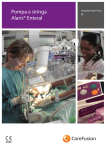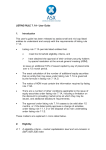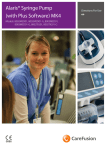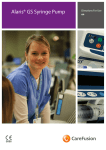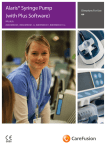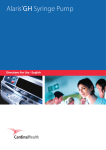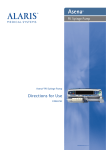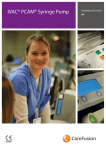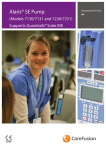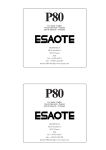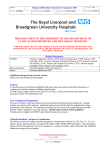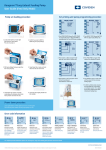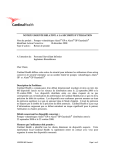Download Alaris ® Enteral Syringe Pump - Directions for Use
Transcript
Alaris® Enteral Syringe Pump s Directions For Use en Alaris® Enteral Syringe Pump Contents Page Introduction. . . . . . . . . . . . . . . . . . . . . . . . . . . . . . . . . . . . . . . . . . . . . . . . . . . . . . . . . . . . . . . . . . . . . . . . . . . . . . . . . . . . . . . . . . . . . . 2 About This Manual. . . . . . . . . . . . . . . . . . . . . . . . . . . . . . . . . . . . . . . . . . . . . . . . . . . . . . . . . . . . . . . . . . . . . . . . . . . . . . . . . . . . . . . . 2 Features of the Alaris® Enteral Syringe Pump. . . . . . . . . . . . . . . . . . . . . . . . . . . . . . . . . . . . . . . . . . . . . . . . . . . . . . . . . . . . . . . 3 Controls and Indicators . . . . . . . . . . . . . . . . . . . . . . . . . . . . . . . . . . . . . . . . . . . . . . . . . . . . . . . . . . . . . . . . . . . . . . . . . . . . . . . . . . . 4 Symbol Definitions. . . . . . . . . . . . . . . . . . . . . . . . . . . . . . . . . . . . . . . . . . . . . . . . . . . . . . . . . . . . . . . . . . . . . . . . . . . . . . . . . . . . . . . . 5 Main Display Features. . . . . . . . . . . . . . . . . . . . . . . . . . . . . . . . . . . . . . . . . . . . . . . . . . . . . . . . . . . . . . . . . . . . . . . . . . . . . . . . . . . . . 6 Operating Precautions . . . . . . . . . . . . . . . . . . . . . . . . . . . . . . . . . . . . . . . . . . . . . . . . . . . . . . . . . . . . . . . . . . . . . . . . . . . . . . . . . . . . 7 Getting Started . . . . . . . . . . . . . . . . . . . . . . . . . . . . . . . . . . . . . . . . . . . . . . . . . . . . . . . . . . . . . . . . . . . . . . . . . . . . . . . . . . . . . . . . . . . 9 Loading and Confirming a Syringe. . . . . . . . . . . . . . . . . . . . . . . . . . . . . . . . . . . . . . . . . . . . . . . . . . . . . . . . . . . . . . . . . . . . . . . . 11 Starting the Alaris® Enteral Syringe Pump. . . . . . . . . . . . . . . . . . . . . . . . . . . . . . . . . . . . . . . . . . . . . . . . . . . . . . . . . . . . . . . . . 13 Basic Features. . . . . . . . . . . . . . . . . . . . . . . . . . . . . . . . . . . . . . . . . . . . . . . . . . . . . . . . . . . . . . . . . . . . . . . . . . . . . . . . . . . . . . . . . . . . 14 Alarms and Warnings. . . . . . . . . . . . . . . . . . . . . . . . . . . . . . . . . . . . . . . . . . . . . . . . . . . . . . . . . . . . . . . . . . . . . . . . . . . . . . . . . . . . . 17 Configured Options. . . . . . . . . . . . . . . . . . . . . . . . . . . . . . . . . . . . . . . . . . . . . . . . . . . . . . . . . . . . . . . . . . . . . . . . . . . . . . . . . . . . . . 18 Specifications. . . . . . . . . . . . . . . . . . . . . . . . . . . . . . . . . . . . . . . . . . . . . . . . . . . . . . . . . . . . . . . . . . . . . . . . . . . . . . . . . . . . . . . . . . . . 20 Recognised Syringe Types . . . . . . . . . . . . . . . . . . . . . . . . . . . . . . . . . . . . . . . . . . . . . . . . . . . . . . . . . . . . . . . . . . . . . . . . . . . . . . . . 22 Associated Products. . . . . . . . . . . . . . . . . . . . . . . . . . . . . . . . . . . . . . . . . . . . . . . . . . . . . . . . . . . . . . . . . . . . . . . . . . . . . . . . . . . . . . 22 Maintenance. . . . . . . . . . . . . . . . . . . . . . . . . . . . . . . . . . . . . . . . . . . . . . . . . . . . . . . . . . . . . . . . . . . . . . . . . . . . . . . . . . . . . . . . . . . . . 23 IrDA, RS232 and Nurse call Specification . . . . . . . . . . . . . . . . . . . . . . . . . . . . . . . . . . . . . . . . . . . . . . . . . . . . . . . . . . . . . . . . . . 25 Spare Parts . . . . . . . . . . . . . . . . . . . . . . . . . . . . . . . . . . . . . . . . . . . . . . . . . . . . . . . . . . . . . . . . . . . . . . . . . . . . . . . . . . . . . . . . . . . . . . 27 Service Contacts . . . . . . . . . . . . . . . . . . . . . . . . . . . . . . . . . . . . . . . . . . . . . . . . . . . . . . . . . . . . . . . . . . . . . . . . . . . . . . . . . . . . . . . . . 28 Document History. . . . . . . . . . . . . . . . . . . . . . . . . . . . . . . . . . . . . . . . . . . . . . . . . . . . . . . . . . . . . . . . . . . . . . . . . . . . . . . . . . . . . . . . 28 1000DF00601 Issue 1 1/28 Alaris® Enteral Syringe Pump Introduction Introduction This Directions For Use applies to Alaris® Enteral Syringe Pump. The Alaris® Enteral Syringe Pump functions with a wide range of standard, single-use, disposable enteral syringes together with the appropriate enteral Administration sets. The Alaris® Enteral Syringe Pump accepts syringe sizes from 5ml to 50/60ml. Intended Purpose The Alaris® Enteral Syringe Pump is intended exclusively for enteral administration. Conditions of Use The Alaris® Enteral Syringe Pump should only be operated by a clinician competent in use of automated enteral pumps and postplacement management of enteral catheters. Only enteral syringes and catheters should be used. A Wrong route errors can be life threatening. Connectors used on enteral feeding systems should be incompatible with other medical device connectors (especially those used for intravenous or other parenteral routes). CareFusion recommends use of enteral catheters and enteral giving sets meeting European Standard EN 1615:2000. Three-way taps and syringe tip adaptors should not be used in enteral feeding systems. A CareFusion cannot guarantee the continued system accuracy with other manufacturer’s enteral syringes as identified in the ‘Recognised Syringe Types’ table. Manufacturers may change syringe specification significant to system accuracy without prior notification. Indications The Alaris® Enteral Syringe Pump is specifically indicated for the delivery of enteral therapies via Nasogastric, Orogastric or Gastrostomy (e.g. PEG - Percutaneous Endoscopic Gastrostomy) routes. Contraindications The Alaris® Enteral Syringe Pump is contraindicated for: • intravascular infusion therapies • subcutaneous infusion therapies • intrathecal and epidural infusion therapies About This Manual Users are advised to read, to understand this manual and to be thoroughly familiar with the Alaris® Enteral Syringe Pumps prior to operating. All illustrations used in this manual show typical settings and values which may be used in setting up the functions of the Alaris® Enteral Syringe Pump. These settings and values are for illustrative use only. Where stated, a minimum delivery rate refers to a nominal rate of 1.0ml/h, and an intermediate delivery rate refers to a nominal rate of 5.0ml/h. The complete range of delivery rates, settings and values are shown in the 'Specifications' section. Conventions used in this manual BOLD Used for Display names, software commands, controls and indicators referenced in this manual, for example, Battery Indicator, PURGE, ON/OFF button. 'Single quotes' Used to indicate cross-references made to another section of this manual. Italics Used to refer to other documents or manuals and also used for emphasis. A Important Information: Wherever this symbol is shown an Important note is found. These notes highlight an aspect of use that is important for the user to be aware of when operating the Alaris® Enteral Syringe Pump. 1000DF00601 Issue 1 2/28 Alaris® Enteral Syringe Pump Features of the Alaris® Enteral Syringe Pump Features of the Alaris® Enteral Syringe Pump ON/OFF Release lever for MDI Display RUN High visibility Alarm Indicator PURGE MUTE PRESSURE OPTION Finger Grips Hook HOLD Rating Plate (see Symbol Definitions for an explanation of the symbols used) Shelf for chevron keys and softkeys Positive Plunger Grippers Syringe Clamp Release lever for Rotating Cam Rotating Cam to lock on to horizontal rectangular bars Carrying Handle Medic al Dev ice Int erface (MDI) IR Communications port Potential Equalisation (PE) connector 1000DF00601 Issue 1 Folded Pole Clamp RS232 Connector 3/28 Hook Alaris® Enteral Syringe Pump Controls and Indicators Controls and Indicators Controls: Symbol Description a b h c ON/OFF button - Press once to switch the Alaris® Enteral Syringe Pump ON. Press and hold down for 3 seconds to switch the Alaris® Enteral Syringe Pump OFF. RUN button - Press to start feeding. The green LED will flash during delivery. HOLD button - Press to put the delivery on hold. The amber LED will be lit while on hold. MUTE button - Press to silence alarm for two minutes. When not in alarm press and hold until four audible 'beeps' are sounded for 15 minutes silence. PURGE/BOLUS button - Press to access PURGE or BOLUS soft keys. Press and hold down soft key to operate. PURGE - primes the feeding tube during initial set up. i • Alaris® Enteral Syringe Pump is on hold • Administration set must not be connected to the patient • Volume Delivered is not added to total volume delivered BOLUS - fluid or drug delivered at an accelerated rate. • Alaris® Enteral Syringe Pump is delivering • Administration set should be connected to the patient • Volume Delivered is added to total volume delivered d e f g OPTION button - Press to access optional features, see 'Basic Features' section. PRESSURE button - Use this button to display the Alaris® Enteral Syringe Pumping pressure and alarm level. CHEVRON keys - Double or single for faster/slower increase or decrease of values shown on display. BLANK SOFTKEYS - Use in conjunction with the prompts shown on the display. Indicators: Symbol j S Description BATTERY indicator - When illuminated the Alaris® Enteral Syringe Pump is running on the internal battery. When flashing the battery power is low with less than 30 minutes of use remaining. AC POWER indicator - When illuminated the Alaris® Enteral Syringe Pump is connected to an AC power supply and the battery is being charged. 1000DF00601 Issue 1 4/28 Alaris® Enteral Syringe Pump Symbol Definitions Symbol Definitions Labelling Symbols: Symbol Description w x y l IPX1 r s T t U W Attention (Consult accompanying documents) Potential Equalisation (PE) Connector RS232/Nurse call Connector Defibrillation-proof type CF applied part (Degree of protection against electrical shock) Protected against vertically falling drops of water Alternating Current Device complies with the requirements of Council Directive 93/42/EEC as amended by 2007/47/EC. Date of Manufacture Manufacturer Not for Municipal Waste Fuse Rating +40°C 0°C EC REP Operating Temperature Range - Alaris® Enteral Syringe Pump can be used between 0 and 40 degrees centigrade. Authorised Representative in the European Community 1000DF00601 Issue 1 5/28 Alaris® Enteral Syringe Pump Main Display Features Main Display Features Pressure Information Syringe type fitted Status ON HOLD PENTA ENTERAL 60 VOLUME 0.0ml + ADJUST - VOLUME Volume Delivered Delivery Rate VTBD Volume Delivered Option VTBD Option Screen Icons Symbol l N Description Time remaining display icon - Indicates time before syringe will require replacement. BATTERY icon - Indicates battery charge level to highlight when the battery will require recharging or re-connection to mains power supply. 1000DF00601 Issue 1 6/28 Alaris® Enteral Syringe Pump Operating Precautions Operating Precautions Disposable Syringes and Administration Sets n o • The Alaris® Enteral Syringe Pump has been calibrated for use with single-use enteral syringes. To ensure correct and accurate operation, only use the brand, model and size of enteral syringes described in this manual. Use of non recognised enteral syringe types may impair the operation of the Alaris® Enteral Syringe Pump and the accuracy of the delivery. • Users are advised to re-evaluate syringe performance periodically as the syringe manufacturer may change specifications significant to accuracy without notice. Users concerned about any observed change in performance are advised to contact their local CareFusion representative. • Uncontrolled flow or syphoning may result if the syringe is located incorrectly in the Alaris® Enteral Syringe Pump, or if it is removed from the Alaris® Enteral Syringe Pump before the administration set is properly isolated from the patient. Isolation may include closing a tap in the patient line or activating a flow stop clamp. • The user must be thoroughly familiar with instructions in this Directions For Use and understand how to load and confirm the syringe on the Alaris® Enteral Syringe Pump. Incorrect syringe loading may result in misidentification of the syringe brand/model and size which may lead to significant inaccuracy of the delivery rate and may also affect Alaris® Enteral Syringe Pump performance. • Secure the feeding tube to the Alaris® Enteral Syringe Pump using the hook at the rear of the Alaris® Enteral Syringe Pump. This provides protection against accidental dislodging of the syringe from the Alaris® Enteral Syringe Pump. Operating Environment • Intended environments include general wards, neonatal wards, paediatric wards, critical and intensive care, operating rooms, accident and emergency rooms. Ensure that the Alaris® Enteral Syringe Pump is appropriately attached using the provided pole clamp. If the Alaris® Enteral Syringe Pump is dropped or experiences any severe physical disturbances, remove it from service and arrange a thorough inspection by appropriately trained technical personnel as soon as is practically possible. • The Alaris® Enteral Syringe Pump is suitable for use in hospital and clinical environments other than domestic establishments and those directly connected to the public single phase AC mains power supply network that supplies buildings used for domestic purposes. However, it may be used in domestic establishments under the supervision of medical professionals with additional necessary appropriate measures. (Consult Technical Service Manual, appropriately trained technical personnel or CareFusion for further information). • The Alaris® Enteral Syringe Pump is not intended to be used in the presence of a flammable anaesthetic mixture with air or oxygen or nitrous oxide. Operating Pressure • This is a positive pressure pump designed to achieve accurate fluid administration. Alarm Conditions J • Several alarm conditions detected by the Alaris® Enteral Syringe Pump will stop the delivery and generate visual and audible alarms. Users are to remain vigilant during delivery to ensure that the therapy is progressing correctly and no alarms are operating. 1000DF00601 Issue 1 7/28 Alaris® Enteral Syringe Pump Operating Precautions Hazards B A V • n explosion hazard exists if the Alaris® Enteral Syringe Pump is used in the presence of flammable A anaesthetics. Exercise care to locate the Alaris® Enteral Syringe Pump away from any such hazardous sources. • angerous Voltage: An electrical shock hazard exists if the Alaris® Enteral Syringe Pump’s casing is opened D or removed. Refer all servicing to qualified service personnel. • hen connected to an external power source, a three-wire (Live, Neutral, Earth) supply must be used. If W the integrity of the external protective conductor in the installation or its arrangement is in doubt, the Alaris® Enteral Syringe Pump should be operated from the battery. • o not open the RS232/Nurse Call protective covering when not in use. Electrostatic discharge (ESD) D precautions are required when connecting RS232/Nurse Call. Touching the pins of the connectors may result in ESD protection failure. It is recommended that all actions must be taken by appropriately trained personnel. • I f the Alaris® Enteral Syringe Pump is dropped, subjected to excessive moisture, fluid spillage, humidity or high temperature, or otherwise suspected to have been damaged, remove it from service for inspection by a qualified service engineer. When transporting or storing the Alaris® Enteral Syringe Pump, use original packaging where possible, and observe to temperature, humidity and pressure ranges stated in the 'Specifications' section and on the outer packaging. L Electromagnetic Compatibility and Interference M K • T he Alaris® Enteral Syringe Pump is protected against the effects of external interference, including high energy radio frequency emissions, magnetic fields and electrostatic discharge (for example, as generated by electrosurgical and cauterising equipment, large motors, portable radios, cellular telephones etc.) and is designed to remain safe when abnormally high levels of interference are encountered. • T herapeutic Radiation Equipment: Do not use the Alaris® Enteral Syringe Pump in the vicinity of any Therapeutic Radiation Equipment. Levels of radiation generated by the radiation therapy equipment such as Linear Accelerator, may severely affect functioning of the Alaris® Enteral Syringe Pump. Please consult manufacturer’s recommendations for safe distance and other precautionary requirements. For further information, please contact your local CareFusion representative. • agnetic Resonance Imaging (MRI): The Alaris® Enteral Syringe Pump contains ferromagnetic materials M which are susceptible to interference with magnetic field generated by the MRI devices. Therefore, the Alaris® Enteral Syringe Pump is not considered an MRI compatible pump. If use of the Alaris® Enteral Syringe Pump within an MRI environment is unavoidable, then CareFusion highly recommends securing the Alaris® Enteral Syringe Pump at a safe distance from the magnetic field outside the identified ‘Controlled Access Area’ in order to evade any magnetic interference to the Alaris® Enteral Syringe Pump; or MRI image distortion. This safe distance should be established in accordance with the manufacturers’ recommendations regarding electromagnetic interference (EMI). For further information, please refer to the product Technical Service Manual (TSM). Alternatively, contact your local CareFusion representative for further guidance. • ccessories: Do not use any non-recommended accessory with the Alaris® Enteral Syringe Pump. A The Alaris® Enteral Syringe Pump is tested and compliant with the relevant EMC claims only with the recommended accessories. Use of any accessory, transducer or cable other than those specified by CareFusion may result in increased emissions or decreased Alaris® Enteral Syringe Pump immunity. • T his Alaris® Enteral Syringe Pump is a CISPR 11 Group 1 Class A device and uses RF energy only for its internal function in the normal product offering. Therefore, its RF emissions are very low and are not likely to cause any interference with the nearby electronic equipment. However, the Alaris® Enteral Syringe Pump emits a certain level of electromagnetic radiation which is within the levels specified by IEC/ EN60601-1-2. If the Alaris® Enteral Syringe Pump interacts with other equipment, measures should be taken to minimise the effects, for instance by repositioning or relocation. • I n some circumstances the Alaris® Enteral Syringe Pump may be affected by an electrostatic discharge through air at levels close to or above 15kv; or by radio frequency radiation close to or above 10v/m. If the Alaris® Enteral Syringe Pump is affected by this external interference the Alaris® Enteral Syringe Pump will remain in a safe mode; the Alaris® Enteral Syringe Pump will stop the delivery and alert the user by generating a combination of visual and audible alarms. Should any alarm condition persist after user intervention, it is recommended to remove the Alaris® Enteral Syringe Pump from service. (Consult Technical Service Manual for further information). 1000DF00601 Issue 1 8/28 Alaris® Enteral Syringe Pump Getting Started Getting Started Initial Set-up A Before operating the Alaris® Enteral Syringe Pump read this Directions For Use manual carefully. 1. C heck that the Alaris® Enteral Syringe Pump is complete, undamaged and that the voltage rating specified on the label is compatible with your AC power supply. 2. Items supplied are: • Alaris® Enteral Syringe Pump • User Support CD (Directions For Use) • AC Power Cable (as requested) • Protective Packaging 3. Connect the Alaris® Enteral Syringe Pump to the AC power supply for at least 2½ hours to ensure that the internal battery is charged (verify that the S is lit). Language Selection 1. O n initial start-up the Alaris® Enteral Syringe Pump will display the Select Language screen. 2. Select the required language from the list displayed using the f keys. 3. Press the OK softkey to confirm your selection. A A The Alaris® Enteral Syringe Pump will automatically operate from its internal battery if the Alaris® Enteral Syringe Pump is switched on without being connected to the AC power supply. Should an Alaris® Enteral Syringe Pump fail comissioning, replace in its original protective packaging, where possible and contact a qualified service engineer for investigation. 1000DF00601 Issue 1 9/28 Alaris® Enteral Syringe Pump Getting Started A Do not mount the Alaris® Enteral Syringe Pump with the AC power inlet pointing upwards. This could affect the electrical safety in the event of a fluid spill. Pole Clamp Installation The pole clamp is fitted to the rear of the Alaris® Enteral Syringe Pump and will provide secure fixing to vertical drip poles of a diameter between 15 and 40 mm. Recess 1. Pull the folded pole clamp towards you and unscrew the clamp to leave enough room for the size of the pole. 2. Place Alaris® Enteral Syringe Pump around pole and tighten screw until the clamp is secured to the pole. A Ensure the pole clamp is folded away and stored within the recess at the rear of the Alaris® Enteral Syringe Pump before connecting to a Docking Station/ Workstation* or when not in use. Never mount the Alaris® Enteral Syringe Pump such that the stand becomes top heavy or unstable. Docking Station/Workstation* or Equipment Rail Installation The rotating cam can be fitted to the rectangular bar on the Docking Station/Workstation* or the equipment rail measuring 10 by 25mm. 1. A lign the rotating cam on the rear of the Alaris® Enteral Syringe Pump with the rectangular bar on the Docking Station/Workstation* or the equipment rail. 2. Hold the Alaris® Enteral Syringe Pump horizontally, push the Alaris® Enteral Syringe Pump firmly onto the rectangular bar or equipment rail. 3. The Alaris® Enteral Syringe Pump should click into position when fitted to the bar. 4. Ensure that the Alaris® Enteral Syringe Pump is positioned securely. 5. To release, push the release lever and pull the Alaris® Enteral Syringe Pump forwards. Rectangular bar Release lever (push to release) Rotating cam * Alaris® Gateway Workstation and Alaris® DS Docking Station 1000DF00601 Issue 1 10/28 Alaris® Enteral Syringe Pump Loading and Confirming a Syringe Loading and Confirming a Syringe A Warning: To securely load and confirm a syringe carefully follow the steps below. Loading a syringe incorrectly may result in misidentification of the syringe. If incorrectly confirmed, this may lead to significant inaccuracy of the delivery rate and may also affect Alaris® Enteral Syringe Pump performance. Only use a syringe of the brand/model stated on the Alaris® Enteral Syringe Pump display or in this manual. Using a non recognised enteral syringe type could adversely affect the accuracy of the delivery rate and may also affect Alaris® Enteral Syringe Pump performance. When drawing fluid into the syringe, draw enough to compensate for any 'dead space' volume in the feeding tube and syringe at the end of delivery as this cannot be fully administered. Finger Grips Plunger Grippers Plunger Flange Plunger Plunger Holder Syringe Barrel Barrel Flange Syringe Clamp Syringe Flange Clamp Place the Alaris® Enteral Syringe Pump on a stable horizontal surface or secure as described previously. Prepare, load and prime the single-use enteral syringe and administration set using standard techniques. 1. Squeeze the finger grips together on the plunger holder and slide the mechanism to the right. 2. Pull the syringe clamp forward and down. 1000DF00601 Issue 1 11/28 Alaris® Enteral Syringe Pump Loading and Confirming a Syringe 3. Insert the syringe ensuring that the barrel flange is located in the slots on the syringe flange clamp. A To ensure the syringe is loaded correctly, place the barrel flange in the space between the syringe clamp and the syringe flange clamp. This is correct if the syringe remains in position before the syringe clamp is closed. 4. Lift the syringe clamp until it locks against the syringe barrel. 5. Squeeze the finger grips on the plunger holder and slide the mechanism to the left until it reaches the plunger end. 6. Release the finger grips. Ensure that the plunger grippers are securing the plunger in place and the finger grip returns to its original position. 7. Ensure that the syringe type and size match those displayed on the Alaris® Enteral Syringe Pump display then press CONFIRM. If required, the make of syringe can be changed by pressing the TYPE softkey. ON HOLD PENTA ENTERAL CONFIRM A 60 TYPE Secure the feeding tube using the hook at the rear of the Alaris® Enteral Syringe Pump. This provides protection against accidental dislodging of the syringe from the Alaris® Enteral Syringe Pump. Ensure that both plunger grippers are fully locked onto the plunger flange and the upper finger grip has returned to its original position. 1000DF00601 Issue 1 12/28 Alaris® Enteral Syringe Pump Starting the Alaris® Enteral Syringe Pump Starting the Alaris® Enteral Syringe Pump 1. C onnect the Alaris® Enteral Syringe Pump to an AC power supply using the AC power cable. 2. Press the a button. • The Alaris® Enteral Syringe Pump will run a short self-test. Ensure that two beeps are activated during this test. • Check the display test pattern and ensure that no rows are missing. • Check that the displayed time and date are correct. • Finally check display shows the data set name and version number. Note: A warning - REPAIRING LOGS, may be displayed if event log information was not completely stored at the previous power down. This is for information only, the Alaris® Enteral Syringe Pump will continue to power up as normal. 3. CLEAR SETUP • Selecting NO will keep previous setup and go to step 8. • Selecting YES will clear previous setup and will go to step 4. A Clear setup screen will only be displayed if a previous setup was used. 4. Load the syringe according to the procedure in this manual. 5. Ensure that the syringe type and size match those displayed on the Alaris® Enteral Syringe Pump then press CONFIRM. If required, the make of syringe can be changed by pressing the TYPE softkey. 6. Purge (if required) - Press the i button and then press and hold the PURGE softkey until fluid flows and the purging of the administration set is complete. Release the softkey. The volume used during purging will be displayed. 7. Check the rate shown if set and change the rate if necessary using the f keys. 8. Connect the administration set to the patient access device. 9. Press b to commence operation. • The amber stop light will be replaced by the flashing green start light to indicate that the Alaris® Enteral Syringe Pump is in operation. RUNNING will be displayed. 10. Press h to halt the operation. ON HOLD will be displayed. The amber stop light will replace the green start light. 1000DF00601 Issue 1 13/28 Alaris® Enteral Syringe Pump Basic Features Basic Features Bolus Delivery Bolus Administering a controlled volume of fluid or drug at an increased rate. Bolus can be used at the start of a delivery or during feeding. A During BOLUS the pressure limit alarm is temporarily increased to the maximum level. BOLUS Enabled - Hands-On In Hands-On Bolus, press and hold the (flashing) BOLUS softkey to deliver the required bolus. The bolus rate can be adjusted. The bolus volume is limited in the configuration. 1. D uring delivery press the i button once to display the bolus screen. 2. Use the f keys to adjust the bolus rate if required. 3. To deliver the bolus press and hold the BOLUS softkey. During the bolus, the volume being delivered is displayed. When the desired bolus volume has been delivered or the bolus volume limit is reached, release the softkey. The bolus volume is added to the total volume delivered. A If the volume to be delivered (VTBD) is reached during a bolus, the VTBD complete alarm will sound. Press c to silence the alarm or CANCEL to acknowledge the alarm. See VTBD section for more details on VTBD operation. Purge The i button allows the delivery of a limited volume of fluid in order to purge the administration set prior to being connected to a patient or after changing a syringe. 1. Press the i button when the Alaris® Enteral Syringe Pump is not delivering. Ensure that the administration set is not connected to the patient. 2. Press and hold the PURGE softkey until fluid flows and the purging of the administration set is complete. The volume used during purging will be displayed, but it is not added to the volume delivered. 3. When purging is complete release the PURGE softkey. Press the QUIT softkey to exit back to the main display. A During PURGE the pressure limit alarms are temporarily increased to their maximum level. Volume to be Delivered (VTBD) This option allows a specific volume to be delivered to be set. Rate at the end of this VTBD can also be set, selecting from stop, KTO (Keep Tube Open), or continuous delivery at the set rate. 1. 2. 3. 4. Press the VTBD softkey to select the volume to be infused option. E nter the volume to be delivered using the f keys and press the OK softkey. Select the rate at the end of the VTBD using the f keys to scroll through the on-screen choices. The default is stop. Press the OK softkey to confirm and exit the VTBD menu. Note: When current VTBD has finished, no other delivery will be allowed unless a new VTBD is set or current VTBD is cleared. Clear Volume This option enables the volume delivered to be cleared. 1. P ress the VOLUME softkey to display the CLEAR VOLUME option. 2. Press the YES softkey to clear the volume. Press the NO softkey to retain the volume. Note: Selecting YES resets the volume delivered in the 24H LOG option. 1000DF00601 Issue 1 14/28 Alaris® Enteral Syringe Pump Basic Features Set VTBD over Time This option allows a VTBD and delivery time to be specified. The rate necessary to deliver the required volume within the specified time is calculated and displayed. Ensure the pump is on hold. Press the d button to access the options menu. S elect the SET VTBD OVER TIME option using the f keys and press the OK softkey. Adjust the volume to be delivered using the f keys. When the desired volume has been reached press the OK softkey. Enter the time over which the volume is to be delivered. The delivery rate will automatically be calculated. Press the OK softkey to enter the value. 5. Select the rate at VTBD end from the list using the f keys and press the OK softkey. The default is STOP. 1. 2. 3. 4. 24 Hour Log This option allows the 24 hour log of volume delivered to be reviewed. 1. Press the d button to access the options menu. 2. Select the 24H LOG option using the f keys and press the OK softkey. The display shows the hourly volume delivered. The volume delivered shown in brackets is the total volume delivered since the volume was last cleared. See example below: 07:48 - 08:00 4.34ml (4.34ml) 08:00 - 09:00 2.10ml (6.44ml) 09:00 - 10:00 2.10ml (8.54ml) VOLUME CLEARED 3. Press the QUIT softkey to exit the log. Event Log This option allows the event log to be reviewed, if enabled. 1. P ress the d button to access the options menu. 2. Select the EVENT LOG option using the f keys and press the OK softkey. 3. Scroll through the log using the f keys. Press the QUIT softkey to exit the log. Data Set Details To review currently selected data set information: 1. P ress the d button to access the options menu. 2. Select DATA SET DETAILS. 3. Review the information and then press the QUIT softkey. A The data set for the Alaris® Enteral Syringe Pump is factory set and can not be configured. 1000DF00601 Issue 1 15/28 Alaris® Enteral Syringe Pump Basic Features Pump Details To review Alaris® Enteral Syringe Pump information. 1. P ress the d button to access the options menu. 2. Select PUMP DETAILS. 3. Review the information and then press the QUIT softkey. Note: The following information will be displayed: • SN • S/W The serial number of the Alaris® Enteral Syringe Pump Software version of the Alaris® Enteral Syringe Pump Adjust Alarm Volume To change the alarm volume, if enabled. 1. Press the d button to access the options menu. 2. Select ADJUST ALARM VOLUME. Note: The Alaris® Enteral Syringe Pump will beep at the selected alarm volume setting. The user must assess whether the alarm volume setting is loud enough for the intended operating environment, and adjust appropriately. 3. Select alarm volume required and press the OK softkey. Pressure Level 1. T o check and adjust the pressure level press the e button. A bar graph will be displayed showing the pressure alarm level and the current pressure level. 2. Press the f keys to increase or decrease the alarm level. The new level will be indicated on the display. 3. Press OK to exit the screen. A The interpretation of the pressure readings and occlusion alarms are the responsibility of the clinician and should include the clinical context in which the Alaris® Enteral Syringe Pump is being used. 1000DF00601 Issue 1 16/28 Alaris® Enteral Syringe Pump Alarms and Warnings Alarms and Warnings Alarms are indicated by a combination of an audible alarm, flashing alarm indicator and a descriptive message in the display, except prompts which only have an audible alarm and message. The delivery will stop for all alarms that show a red alarm indicator. 1. F irst press the c button to silence the alarm for a maximum of 2 minutes, then check the display for an alarm message. Press CANCEL to cancel the alarm message. 2. If the delivery has stopped, rectify the cause of the alarm then press the b button to resume feeding. A If the Alaris® Enteral Syringe Pump initiates a safety processor alarm condition (an audible high pitched continuous trill accompanied with a red alarm indicator) and there is no error message displayed on the Alaris® Enteral Syringe Pump, remove the Alaris® Enteral Syringe Pump from service for examination by a qualified service engineer. A Delivery will stop for all alarms that have a red alarm indicator. Display Alarm Description and Troubleshooting Guide Indicator DRIVE DISENGAGED Red The drive system has been disengaged during operation. Check the finger grips and the position of the syringe. OCCLUSION Red Excessive pressure measured at the syringe plunger exceeding the alarm limit. Identify and remove the cause of the blockage in the drive, syringe, or administration system before restarting delivery. CHECK SYRINGE Red Incorrect size of syringe has been fitted, the syringe has not been positioned correctly or has been disturbed during operation. Check the syringe location and the position. BATTERY LOW BATTERY EMPTY NEAR END OF DELIVERY Amber Red Battery charge low with 30 minutes operation remaining. Reconnect to the AC power supply to charge the internal battery and continue operation. If action is not taken the battery indicator will flash for 30 minutes followed by a continuous audible alarm, red alarm indicator and message BATTERY EMPTY displayed, indicating that the battery is too low to operate the Alaris® Enteral Syringe Pump. The internal battery is too low to operate the Alaris® Enteral Syringe Pump. Immediately connect the Alaris® Enteral Syringe Pump to the AC power supply and cycle the power to resume operation. Amber The Alaris® Enteral Syringe Pump is nearing the end of the delivery. END OF DELIVERY Red The Alaris® Enteral Syringe Pump has reached the end of the delivery and the Alaris® Enteral Syringe Pump has stopped delivering. A pre-set volume will remain in the syringe. VTBD DONE Red The pre-set Volume To Be Delivered is complete and the Alaris® Enteral Syringe Pump has stopped delivering. VTBD DONE Amber The pre-set Volume To Be Delivered is complete and the Alaris® Enteral Syringe Pump continues to deliver at set rate or at KTO rate. AC POWER FAIL Amber AC Power has been disconnected and the Alaris® Enteral Syringe Pump is operating on battery power. If this occurs when the Alaris® Enteral Syringe Pump is operating the message DELIVERY CONTINUES will be displayed. Reconnect AC power supply or press the c button to silence the alarm and continue with battery operation. The alarm will automatically cancel if the AC power supply is reconnected. Error Code and Message ATTENTION (with “3 Beeps”) Red The alarm system has detected an internal malfunction. Note the malfunction code. Remove the Alaris® Enteral Syringe Pump from service for examination by a qualified service engineer. Amber Three beeps will sound if the Alaris® Enteral Syringe Pump has been left ON for more than 2 minutes (referred to as CALLBACK in the log) without starting the operation. Press the c button to silence the alarm for a further 2 minutes. For extended callback press and hold down the c button and wait for four beeps in succession. This will silence the alarm for 15 minutes. 1000DF00601 Issue 1 17/28 Alaris® Enteral Syringe Pump Configured Options Configured Options This section comprises a list of configurable options, which can be entered via the Alaris® Enteral Syringe Pump configuration menu (available in Technician Mode). Enter the access code on the Alaris® Enteral Syringe Pump for Configured Options, see the Technical Service Manual for details. A Access codes should only be entered by qualified technical personnel. Clock Set 1. S elect CLOCK SET from the Configured Options menu using the f keys and press the OK softkey. 2. Use the f keys to adjust the date displayed, pressing the NEXT softkey to access the next field. 3. When the correct time and date are displayed press the OK softkey to return to the Configured Options menu. Language This option is used to set the language of messages shown on the Alaris® Enteral Syringe Pump display. 1. Select LANGUAGE from the Configured Options menu using the f keys and press the OK softkey. 2. Use the f keys to select the language. 3. When the desired language has been selected press SELECT softkey to return to the Configured Options menu. Contrast This option is used to set the contrast on the Alaris® Enteral Syringe Pump display. 1. S elect CONTRAST from the Configured Options menu using the f keys and press the OK softkey. 2. Use the f keys to select a contrast ratio value. The contrast of the display will change when scrolling through the numbers. 3. When the desired value has been reached press the OK softkey to return to the Configured Options menu. General Options 1. 2. 3. 4. S elect GENERAL OPTIONS from the Configured Options menu using the f keys and press the OK softkey. Select the option required to enable/disable or adjust and press the MODIFY softkey. When all the required modifications have been carried out press the QUIT softkey. Either select the next configuration option from the menu or turn the Alaris® Enteral Syringe Pump OFF, returning it to operation as required. NURSE CALL FITTED Enables Nurse Call (hardware option). NURSE CALL INVERT When enabled, the nurse call output is inverted. RS232 SELECTED Sets the Alaris® Enteral Syringe Pump's communications to use RS232 (hardware option). The NURSE CALL FITTED option must be enabled to allow RS232 to be enabled. 1000DF00601 Issue 1 18/28 Alaris® Enteral Syringe Pump Configured Options Configured Options Table Option Description Default NEOD Warning Sets the Near End Of Delivery warning time, as time left to End Of Delivery. 10 minutes EOD Point Sets the End Of Delivery point. 1% KTO Rate The Alaris® Enteral Syringe Pump will switch to running at the KTO rate when EOD is reached. 0.1ml/h VTBD Max Maximum permissible Volume To Be Delivered value. 1000ml Display Syringe Brand Displays the Syringe Brand on the main display. Auto Save Feature to retain previous settings when Alaris® Enteral Syringe Pump is switched on. AC Fail The AC Power Failure Alarm will sound if the AC power is disconnected. Bolus Mode Bolus feature is set to be Hands-On or Hands-Free. Pressure Display Displays the Pressure Icon on the main display. Bolus Rate Default The default value for bolus rate. 10ml/h Bolus Rate Max The maximum value for bolus rate. 200ml/h Bolus Volume Max The maximum permissible bolus volume. 1ml Cap Pressure Sets the maximum pressure value. L10 Pressure Default Sets the default occlusion alarm level. L4 Cap Rate Sets the maximum value for delivery rate. 200ml/h Purge Rate Max Sets the purge rate. 500ml/h Purge Volume Max Sets the maximum permissible purge volume. 2.0ml Call Back Time The time for the Alaris® Enteral Syringe Pump to sound the call back alarm. 2 minutes Event Log Display The event log can be displayed. Battery Icon Displays the Battery Icon on the main display. Audio Volume Sets the alarm volume of the Alaris® Enteral Syringe Pump at high, medium or low. Auto Night Mode Backlight dims between hours 21:00 and 06:00. 1000DF00601 Issue 1 19/28 Medium Alaris® Enteral Syringe Pump Specifications Specifications Delivery Specifications Maximum delivery rate is set at the following: 0.1ml/h - 150ml/h 5ml syringes 0.1ml/h - 200ml/h 10ml syringes 0.1ml/h - 200ml/h 20ml syringes 0.1ml/h - 200ml/h 30ml syringes 0.1ml/h - 200ml/h 50ml syringes The Volume Delivered range is 0.0ml - 9990ml. A The Alaris® Enteral Syringe Pump displays Volume Delivered to 4 characters; however a volume delivered greater than 999ml will increment on the display in multiples of ten. Bolus Specifications Maximum Bolus rates is set at the following 10 ml/h - 150ml/h 5ml syringes 10 ml/h - 200ml/h 10ml syringes 10 ml/h - 200ml/h 20ml syringes 10 ml/h - 200ml/h 30ml syringes 10 ml/h - 200ml/h 50ml syringes Bolus rates are user adjustable, in increments of 10ml/h. The bolus volume limit maximum is 1.0ml During BOLUS the pressure limit alarms are temporarily increased to their maximum level. Critical Volume The bolus which can occur in the event of a single internal fault condition with a 50 ml syringe is : Maximum Overdelivery - 0.5ml Purge Specifications The purge rate is limited to 500ml/h. The purge volume is 2.0ml. During PURGE the pressure limit alarms are temporarily increased to their maximum level. End Of Syringe Rate Stop Volume To Be Delivered (VTBD) 0.10ml - 1000ml, 1min - 24h VTBD Complete Rate Stop, KTO (0.1ml/h), set rate if lower than KTO or continue at set rate. Near End Of Delivery Alarm 10min to end of delivery or 10% of syringe volume, whichever is smaller. End Of Delivery (EOD) Alarm 1% of syringe volume Maximum Alaris® Enteral Syringe Pumping Pressure Limit Highest alarm level 1000mmHg (nominal at L-10) Occlusion Accuracy without pressure set (% of full scale)* Pressure mmHg Temp. 23°C L-0 L-3 L-5 L-10 approx. 50mmHg approx. 300mmHg approx. 500mmHg approx. 1000mmHg ±18% ±21% ±23% ±28% * - Using most common 50ml syringes under normal conditions (95% confidence / 95% of Alaris® Enteral Syringe Pumps). 1000DF00601 Issue 1 20/28 Alaris® Enteral Syringe Pump Specifications System Accuracy Volumetric Mean +/- 2% for rates ≥ 1ml/h (nominal). • Derating - Temperature +/- 0 5% (5 - 40ºC), High Rates +/-2.0% (rates > syringe volume/h eg. >50ml/h in a 50ml syringe.) A System accuracy is +/-2% typical by volume as measured using deionised water at rates of 1.0ml/h (23ºC) and above when the Alaris® Enteral Syringe Pump is used with the Penteferte Enteral and CareFusion Enteral syringes. Differences in factors such as size and plunger force in recognised syringes can cause variations in accuracy. Electrical Classification Class I product. Continuous Mode Operation, Transportable Battery Specifications Rechargeable sealed NiMH. Automatically charges when the Alaris® Enteral Syringe Pump is connected to AC power. Mean Time To Battery Empty from fully charged at 5ml/h & 23°C under normal conditions is 6 hours* *95% lower confidence interval of 5 hours 50 minutes Charging takes 2½ hours from discharge to 90% charge. Memory Retention The electronic memory of the Alaris® Enteral Syringe Pump will be retained for at least 6 months when not powered up. Fuse Type 2 x T 1.25A, slow blowing. AC Power Supply 115 - 230VAC, 50 - 60Hz, 20VA (nominal). Dimensions 310 mm (w) x 121 mm (h) x 200 mm (d). Weight 2.7 kg (excluding power cable). Protection against fluid ingress IPX1 - Protected against vertically falling drops of water. Alarm Conditions Drive Disengaged Occlusion Attention (Nurse Callback) Check Syringe Battery Low AC Power Fail Internal Malfunction Battery Empty VTBD Done Near End Of Delivery End of Delivery Environmental Specifications Operating Temperature 0°C - +40°C Operating Relative Humidity 20% - 90% Operating Atmospheric Pressure 700hPa - 1060hPa Transport & Storage Temperature -30°C - +50°C Transport & Storage Relative Humidity 10% - 95% Transport & Storage Atmospheric Pressure 500hPa - 1060hPa Electrical/Mechanical Safety Complies with EN/IEC60601-1 and EN/IEC60601-2-24. EMC Complies with EN/IEC60601-1-2 and EN/IEC60601-2-24. 1000DF00601 Issue 1 21/28 Alaris® Enteral Syringe Pump Recognised Syringe Types Recognised Syringe Types The Alaris® Enteral Syringe Pump is designed to recognise single-use disposable enteral syringes. The table below lists the enteral syringes recognised by the Alaris® Enteral Syringe Pump. Model 5ml 10ml 20ml 30ml CareFusion Enteral1 0000ME00870 0000ME00871 0000ME00872 0000ME00873 Pentaferte Enteral 2022590 2022690 2022790 2022990 1015.102 1015 212 1015.602 1015 213 1015.603 Vygon Enteral* Vygon A-VY Enteral* 50ml 0000ME00874 Medicina B.Tip* Medicina Enteral* Nutricair* 60ml Bladder Tip PE60B PE05 PE10 PE20 SE10 SE20 Terumo Enteral* PE60 SE50 SS+30EO SS+50EO/C 1 Please contact your local CareFusion representative for availability. A CareFusion has characterized a range of enteral syringes as identified in the ‘Recognised Syringe Types’ table. CareFusion cannot guarantee the continued system accuracy of these recognised enteral syringes* as the manufacturer may change syringe specification significant to system accuracy without prior notification. In no event shall CareFusion be liable for any damages of any kind or nature, including without limitation, direct or indirect, special, consequential, or incidental damages arising from, or in connection with the use of enteral syringes not listed in the ‘Recognised Syringe Types’ table. Associated Products The Alaris® Gateway Workstation 1000DF00601 Issue 1 The Alaris® DS Docking Station 22/28 Alaris® Enteral Syringe Pump Maintenance Maintenance Routine Maintenance Procedures To ensure that this Alaris® Enteral Syringe Pump remains in good operating condition, it is important to keep it clean and carry out the routine maintenance procedures described below. Interval Routine Maintenance Procedure As per Hospital Policy Thoroughly clean external surfaces of the Alaris® Enteral Syringe Pump before and after prolonged period of storage. Each usage 1. Inspect AC power supply plug and cable for damage. 2. Inspect case, keypad and plunger for damage. 3. Check Start up self test operation is correct. Before the transfer of the Alaris® Enteral Syringe Pump to a new patient and as required A Clean the Alaris® Enteral Syringe Pump by wiping over with a lint-free cloth lightly dampened with warm water and a standard disinfectant / detergent solution. If the Alaris® Enteral Syringe Pump is dropped, damaged, subjected to excessive moisture or high temperature, immediately take it out of service for examination by a qualified service engineer. All preventative and corrective maintenance shall be performed at a compliant work place in accordance with the information supplied. CareFusion will not be responsible should any of these actions be performed outside the instructions or information supplied by CareFusion. For Preventative and Corrective Maintenance instructions please refer to the Technical Service Manual (TSM). All preventative and corrective maintenance and all such activities should be performed by a qualified service engineer only, with reference to the TSM. A Please refer to Technical Service Manual for calibration procedures. The units of measurement used in the calibration procedure are standard SI units (The International System of Units). Battery Operation The internal rechargeable battery allows continued operation when the AC power is unavailable, for example during patient transfer or AC power failure. Mean Time To Battery Empty from fully charged @ 5ml/h & 23°C under normal conditions is 6 hours*. From the battery low alarm it will take 2½ hours to 90% charge when reconnected to the AC power supply, whether the Alaris® Enteral Syringe Pump is in use or not. The battery is maintenance free, sealed Nickel Metal Hydride and requires no routine servicing. However, to achieve optimum operation, ensure that the battery is fully recharged after full discharge, before storage, and at regular 3 month intervals during storage. It is recommended that only a qualified service engineer replaces the battery, only use a CareFusion recommended battery. For further information regarding the replacement of batteries refer to the Technical Service Manual. The battery pack used in this Alaris® Enteral Syringe Pump is manufactured by CareFusion and includes a proprietary PCB (printed circuit board) designed specifically for the Alaris® Enteral Syringe Pump, and in conjunction with Alaris® Enteral Syringe Pump software, controls battery use, charge and temperature. Any use of battery packs that are not manufactured by CareFusion in the Alaris® Enteral Syringe Pump is at your sole risk, and CareFusion does not provide any warranty for or endorsement on any battery packs that are not manufactured by CareFusion. CareFusion’s product warranty shall not apply in the event the Alaris® Enteral Syringe Pump has suffered damage or premature wear, or malfunctions or otherwise operates incorrectly, as a result of use with a battery pack that is not manufactured by CareFusion. *95% lower confidence interval of 5 hours 50 minutes 1000DF00601 Issue 1 23/28 Alaris® Enteral Syringe Pump Maintenance Cleaning and Storage Before the transfer of the Alaris® Enteral Syringe Pump to a new patient and periodically during the use, clean the Alaris® Enteral Syringe Pump by wiping over with a lint-free cloth lightly dampened with warm water and a standard disinfectant / detergent solution. Do not use the following disinfectant types: • Disinfectants which are known to be corrosive to metals must not be used, these include: • NaDcc (such as Presept), • Hypochlorites (such as Chlorasol), • Aldehydes (such as Cidex), • Cationic Surfactants (such as Benzalkonium Chloride). • Use of Iodine (such as Betadine) will cause surface discoloration. • Concentrated Isopropyl alcohol based cleaners will degrade plastic parts. Recommended cleaners are: Brand Concentration Hibiscrub 20% (v/v) Virkon 1% (w/v) The following products were tested and are acceptable for use on the Alaris® Enteral Syringe Pump if used in accordance with the specified manufacturer’s guidelines. • • • • • • • • • • • • • Warm soapy water Mild detergent in water (e.g. Young’s Hospec) 70% Isopropyl Alcohol in water Chlor-Clean Clinell Sporicidal wipes Hibiscrub TriGene Advance Tristel Fuse sachets Tristel Trio wipes system Tuffie 5 wipe Virkon Disinfectant Virusolve+ (Ready To Use) Virusolve+ (Wipes) A Before cleaning always switch OFF and disconnect from the AC power supply. Never allow liquid to enter the casing and avoid excess fluid build up on the Alaris® Enteral Syringe Pump. Do not use aggressive cleaning agents as these may damage the exterior surface of the Alaris® Enteral Syringe Pump. Do not steam autoclave, ethylene oxide sterilise or immerse this Alaris® Enteral Syringe Pump in any fluid. If the Alaris® Enteral Syringe Pump has visible cracks or damage to the case do not clean and immediately take out of service for examination by a qualified service engineer. The syringe and administration sets are disposable single use items and should be discarded after use according to their manufacturers’ instructions. If the Alaris® Enteral Syringe Pump is to be stored for an extended period it should be first cleaned and the internal battery fully charged. Store in a clean, dry atmosphere at room temperature and, if available, employ the original packaging for protection. Once every 3 months during storage, carry out functional tests as described in the Technical Service Manual and ensure that the internal battery is fully charged. Disposal Information on Disposal for Users of Waste Electrical & Electronic Equipment This U symbol on the product and/or accompanying documents means that used electrical and electronic products should not be mixed with household waste. If you wish to discard electrical and electronic equipment, please contact your CareFusion affiliate office or distributor for further information. Disposing of this product correctly will help to save valuable resources and prevent any potential negative effects on human health and the environment which could otherwise arise from inappropriate waste handling. Information on Disposal in Countries outside the European Union This symbol is only valid in the European Union. The product should be disposed of taking environmental factors into consideration. To ensure no risk or hazard, remove the internal rechargeable battery and the Nickel Metal Hydride battery from the control board and dispose of as outlined by the local country regulations. All other components can be safely disposed of as per local regulations. 1000DF00601 Issue 1 24/28 Alaris® Enteral Syringe Pump IrDA, RS232 and Nurse call Specification IrDA, RS232 and Nurse call Specification IrDA / RS232 / Nurse call Feature The IrDA or RS232 / Nurse call is a feature on the Alaris® Enteral Syringe Pump that allows connection to a PC or another Alaris® Enteral Syringe Pump. This allows data to be transferred between the Alaris® Enteral Syringe Pump and a PC or another Alaris® Enteral Syringe Pump, (e.g. Event Reports to be downloaded from the Alaris® Enteral Syringe Pump and the Alaris® Enteral Syringe Pump to be monitored remotely via a suitable central monitoring or computer system). A The nurse call interface provides a remote backup to the internal audible alarm. It should not be relied upon to replace monitoring of the internal alarm. Refer to the Technical Service Manual for further information regarding the RS232 interface. Since it is possible to control the Alaris® Enteral Syringe Pump using the RS232 interface at some distance from the Alaris® Enteral Syringe Pump and hence remote from the patient, responsibility for the control of the Alaris® Enteral Syringe Pump is vested in the software run on the computer control system. The assessment for the suitability of any software used in the clinical environment to control or receive data from the Alaris® Enteral Syringe Pump lies with the user of the equipment. This software should include detection of the disconnection or other failure of the RS232 cable. The protocol is detailed in the Alaris® Enteral Syringe Pump Communications Protocol and is for general information only. Any connected analogue and digital components are required to meet IEC/EN60950 for data processing and IEC/EN60601 for medical devices. Anyone connecting additional devices to the signal input or output is a system configurator and responsible for meeting the requirements of the system standard IEC/EN60601-1-1. IrDA Baud Rate 38.4 kBaud Start Bits 1 Start Bit Data Bits 8 Data Bits Parity No Parity Stop Bits 1 stop bit 1000DF00601 Issue 1 25/28 Alaris® Enteral Syringe Pump IrDA, RS232 and Nurse call Specification RS232 / Nurse call Connection Data Nurse call Specification Connector D Type - 9 Pin TXD/RXD EIA RS232-C Standard TXD Output Voltage Range Minimum: -5V (mark), +5V (space) Typical: -7V (mark), +7V (space) with 3kΩ load to ground RXD Input Voltage Range -30V - +30V max. RXD Input Thresholds Low: 0.6V minimum High: 3.0V maximum RXD Input Resistance 3kΩ minimum Enable Active, Low:-7V to -12V Active, High:+7V to +12V, - powers up the isolated RS232 circuitry Inactive: Floating/open circuit, allows isolated RS232 circuitry to power down. Isolation Socket/Alaris® Enteral Syringe Pump 1.5kV (dc, or ac peak) Baud Rate 38.4 kBaud Start Bits 1 Start Bit Data Bits 8 Data Bits Parity No Parity Stop Bits 1 stop bit Nurse Call Relay Contacts Pins 1, 8 + 9, 30V dc, 1A rating Typical Connection Data 1. 2. 3. 4. 5. 6. 7. 8. 9. Nurse call (Relay) Normally Closed (NC C) Transmit Data (TXD) Output Received Data (RXD) Input Power Input (DSR) Ground (GND) Not used Power Input (CTS) Nurse call (Relay) Normally open (NC O) Nurse call (Relay) Common (NC COM) 1000DF00601 Issue 1 26/28 Alaris® Enteral Syringe Pump Spare Parts Spare Parts A comprehensive list of spare parts for this Alaris® Enteral Syringe Pump is included within the Technical Service Manual. The Technical Service Manual (1000SM00001) is now available in electronic format on the World Wide Web at :www.carefusion.com/alaris-intl/ A username and password are required to access our manuals. Please contact a local customer services representative to obtain login details. Part Number Description 1000SP01122 Internal Battery Pack 1001FAOPT91 AC Power Lead - UK 1001FAOPT92 AC Power Lead - European 1000DF00601 Issue 1 27/28 Alaris® Enteral Syringe Pump Service Contacts Service Contacts For service contact your local Affiliate Office or Distributor. AE CN GB NZ CareFusion, PO Box 5527, Dubai, United Arab Emirates. CareFusion, Shanghai Representative Office, Suite A, Floor 24, Shanghai Times Square Office Building, No.500 Zhangyang Road, Shanghai 200122, China. CareFusion, The Crescent, Jays Close, Basingstoke, Hampshire, RG22 4BS, United Kingdom. CareFusion, 14B George Bourke Drive, Mt Wellington 1060, PO Box 14-518, Panmure 1741, Auckland, New Zealand Tel: (971) 4 28 22 842 Tel: (86) 21 58368028 Tel: (44) 0800 917 8776 Tel: 09 270 2420 Freephone: 0508 422734 Fax: (971) 4 28 22 914 Fax: (86) 21 58368017 Fax: (44) 1256 330860 Fax: 09 270 6285 AU DE HU SE CareFusion, 3/167 Prospect Highway, PO Box 355 Seven Hills, NSW 2147, Australia. CareFusion, Pascalstr. 2, 52499 Baesweiler, Deutschland. CareFusion, Döbrentei tér 1, H-1013 Budapest, Magyarország. CareFusion, Hammarbacken 4B, 191 46 Sollentuna, Sverige. Tel: (61) 2 9838 0255 Tel: (49) 2401 604 0 Tel: (36) 14 88 0232 Tel: (36) 14 88 0233 Tel: (46) 8 544 43 200 Fax: (61) 2 9674 4444 Fax: (49) 2401 604 121 Fax: (36) 12 01 5987 Fax: (46) 8 544 43 225 BE DK IT US CareFusion, Leuvensesteenweg 248 D, 1800 Vilvoorde, Belgium. CareFusion, Firskovvej 25 B, 2800 Lyngby, Danmark. CareFusion, Via Ticino 4, 50019 Sesto Fiorentino, Firenze, Italia. CareFusion, 10020 Pacific Mesa Blvd., San Diego, CA 92121, USA. Tel: (32) 2 267 38 99 Tlf. (45)70 20 30 74 Tél: (39) 055 30 33 93 00 Tel: (1) 800 854 7128 Fax: (32) 2 267 99 21 Fax. (45)70 20 30 98 Fax: (39) 055 34 00 24 Fax: (1) 858 458 6179 CA ES NL ZA CareFusion, 235 Shields Court, Markham, Ontario L3R 8V2, Canada. CareFusion, Edificio Veganova, Avenida de La Vega, nº1, Bloque 1 - Planta 1, 28108 Alcobendas, Madrid, España. CareFusion, De Molen 8-10, 3994 DB Houten, Nederland. CareFusion, Unit 2 Oude Molen Business Park, Oude Molen Road, Ndabeni, Cape Town 7405, South Africa. Tel: (1) 905-752-3333 Tel: (34) 902 555 660 Tel: (31) 30 228 97 11 Tel: (27) (0) 860 597 572 Tel: (27) 21 510 7562 Fax: (1) 905-752-3343 Fax: (34) 902 555 661 Fax: (31) 30 225 86 58 Fax: (27) 21 5107567 CH FR NO CareFusion Switzerland 221 Sàrl Critical Care A-One Business Centre Zone d’activitiés Vers-la-Pièce n° 10 1180 Rolle / Switzerland CareFusion, Parc d’affaire le Val Saint Quentin 2, rue René Caudron 78960 Voisins le Bretonneux France CareFusion, Solbråveien 10 A, 1383 ASKER, Norge. Ph.: 0848 244 433 Tél: (33) 1 30 05 34 00 Tel: (47) 66 98 76 00 Fax: 0848 244 100 Fax: (33) 1 30 05 34 43 Fax: (47) 66 98 76 01 Document History Revision CO Number Date 1 10179 April 2010 1000DF00601 Issue 1 28/28 Alaris is a registered trademark of CareFusion Corporation or one of its subsidiaries. All rights reserved. All other trademarks are property of their respective owners. ©2010 CareFusion Corporation or one of its subsidiaries. All rights reserved. This document contains proprietary information of CareFusion Corporation or one of its subsidiaries, and its receipt or possession does not convey any rights to reproduce its contents, or to manufacture or sell any product described. Reproduction, disclosure, or use other than for the intended purpose without specific written authorization of CareFusion Corporation or one of its subsidiaries is strictly forbidden. t CareFusion Switzerland 317 Sàrl, CH-1180, Rolle EC REP CareFusion U.K. 305 Ltd., RG22 4BS, UK 1000DF00601 Issue 1 carefusion.com































